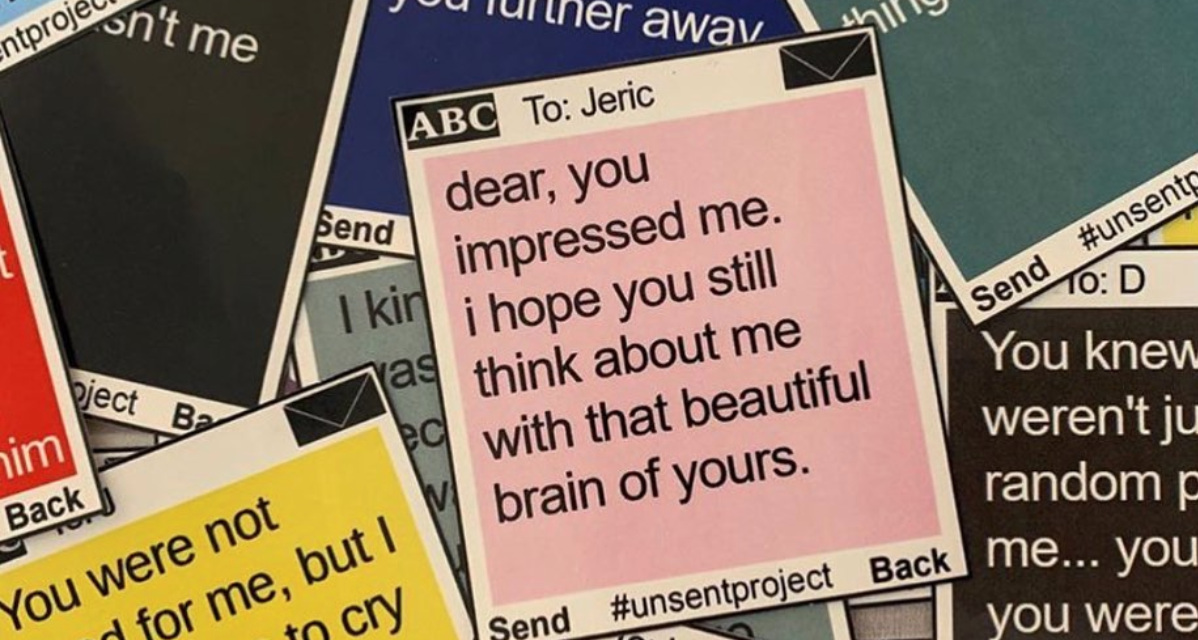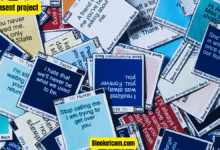The Unsent Project: A Love Letter to Unspoken Feelings

Introduction: What Is The Unsent Project?
Have you ever written a text you never sent? Maybe it was meant for a former lover, a best friend who drifted away, or even a version of yourself that no longer exists. “The Unsent Project” is built around that exact premise — a digital archive of unsent messages, collected from people around the world. It’s intimate, raw, and deeply human.
The Unsent Project was created by artist Rora Blue in 2015 as a way to explore how people express unspoken emotions, especially those rooted in love and heartbreak. Participants submit anonymous messages addressed to a first love, an ex, a crush, or someone they never got the courage to talk to. These messages are then archived and publicly displayed on the website, often accompanied by a chosen color that symbolizes the emotion behind the words.
The project has gained viral attention over the years for its honest, relatable, and sometimes gut-wrenching messages. People find comfort in knowing they aren’t alone in their feelings — that someone else, somewhere, once felt the same. In many ways, The Unsent Project is a testament to the universal language of longing, regret, and hope.
Origins and Purpose: How It All Began

The Unsent Project started as a personal art project. Rora Blue, a multimedia artist known for work that intersects digital culture, emotion, and communication, launched the initiative with the simple idea of collecting anonymous love letters that were never sent.
Initially, it was just a small submission form on her website. She asked participants to write a message to their first love and to choose a color that represents what they felt. The simplicity of the concept struck a chord. Soon, the project evolved into a massive, searchable database containing hundreds of thousands of messages — all anonymous, all honest.
The real magic lies in its dual purpose: part emotional therapy, part social commentary. It helps participants express what they may never get a chance to say, and it also shows viewers that they’re not alone. Each post is a window into someone else’s story — and often, it mirrors our own.
Over time, The Unsent Project has become more than just an art installation. It has grown into a cultural phenomenon, widely shared on Instagram, TikTok, and Twitter. With its deeply emotional content and universal themes, the project transcends age, gender, and background. It invites everyone to take a moment and reflect on the words left unsaid.
The Power of Color: Why Each Message Has a Hue
One of the most visually captivating aspects of The Unsent Project is its color-coding system. When someone submits a message, they choose a color that they associate with the person or the emotion tied to the message. These colors range from vibrant reds to muted grays, and each one adds a unique layer of meaning.
Color plays a significant psychological role in emotional memory. Red might symbolize passion, anger, or love. Blue might represent sadness, longing, or calmness. Yellow could indicate happiness or nostalgia. Each color acts like an emotional filter, framing the message in a specific emotional tone.
Interestingly, Rora Blue later analyzed the most frequently chosen colors and what they represented. Pink and blue often top the list — pink for warmth, care, and sweetness; blue for distance, melancholy, and tranquility. It’s fascinating how consistently people across the world use similar shades to convey the same feelings.
The use of color is not only aesthetic but also deeply symbolic. It gives viewers a deeper sense of the emotional landscape behind the words. You’re not just reading a message — you’re feeling it. And sometimes, just seeing a specific color can evoke the same emotional state in you, making the experience incredibly immersive.
Themes That Resonate: Love, Loss, and Everything In Between
Though The Unsent Project began as a space for messages to first loves, it quickly expanded to include a wide array of relationships and emotions. There’s no limit to who the messages can be addressed to — some are written to ex-partners, best friends, siblings, deceased loved ones, or even to oneself.
Love is undeniably the dominant theme. Whether it’s unrequited, unresolved, or everlasting, love drives the bulk of submissions. People pour their hearts out — confessions of what they never said, apologies they regret not making, or admissions of how deeply someone changed them.
But there’s also a lot of pain. Some messages express betrayal, emotional trauma, or the weight of not being chosen. Others wrestle with the slow fading of a relationship that once meant everything. Then there are messages full of hope — letters imagining a reunion or wishing the other person well, despite everything.
Grief is another strong thread. Some people write to those who’ve passed away, as a form of closure. Others send messages to the younger version of themselves, offering forgiveness or encouragement. These layers make the project not just about romantic love but about the full spectrum of human emotion.
Why People Relate So Deeply: The Psychology Behind Unsent Messages
What makes The Unsent Project so universally appealing? It taps into a core aspect of the human experience: unexpressed emotion. Nearly everyone has something they wish they’d said — whether out of fear, bad timing, or lost opportunities.
Unsent messages are like emotional time capsules. They preserve a moment, a feeling, a “what if” that still lingers in the background of our lives. Writing them down — even anonymously — can be cathartic. It offers a sense of relief, a small form of closure.
There’s also a psychological phenomenon at play here: emotional validation. When people read these messages, they often find that someone else has experienced almost the exact same thing. That validation can be incredibly healing. It tells you that your pain isn’t unique in a way that isolates you — it’s universal in a way that connects us.
Social media has amplified this experience. Seeing people share, comment, and interact with these messages creates a sense of community. Strangers bond over shared emotions, over the haunting power of what was never said. In a digital world often criticized for being superficial, The Unsent Project brings raw vulnerability to the forefront.
The Role of Anonymity: Why We Open Up Without a Name
Anonymity is the heartbeat of The Unsent Project. It strips away the fear of judgment and allows people to be brutally honest. When there’s no risk of being identified, people dig deep and say things they wouldn’t dare voice in real life.
This kind of raw honesty is rare in daily life. We’re taught to hold back, to stay composed, to avoid vulnerability. But in the safety of anonymity, the floodgates open. People confess secrets, unspoken affections, and lifelong regrets with a freedom that feels both liberating and heartbreaking.
Anonymity also levels the playing field. It doesn’t matter where you come from, what you look like, or how old you are. Everyone’s voice carries equal weight. It’s just you, your words, and the emotion behind them.
This is part of what makes The Unsent Project such a rich emotional archive. It’s not curated by fame or influence — it’s shaped by real people navigating real emotions. And the anonymity preserves that authenticity, making the project even more impactful.
How the Unsent Project Reflects Modern Relationships
Today’s relationships are often shaped by fleeting interactions, ghosting, and unspoken feelings. The Unsent Project serves as a mirror to these modern dynamics, capturing the emotional residue left behind when conversations are cut short or never happen at all.
It reflects the way we often use technology as a buffer — texting instead of calling, leaving things unsaid because we’re scared of rejection or awkwardness. Ironically, it’s technology that also enables projects like this to thrive. It provides a space to express what can’t be said face-to-face.
The messages show how much people almost say in their real lives but don’t. They reveal a generation grappling with how to be emotionally honest in a world that moves fast and feels distant. They highlight both the depth and fragility of human connection in the digital age.
And yet, despite all the heartbreak and ambiguity, the messages also pulse with tenderness and longing. They show that even if we don’t always express love well, the feeling is still there, deeply and stubbornly.
Cultural Impact: How The Unsent Project Became a Global Phenomenon
From Tumblr and Instagram to mainstream press, The Unsent Project has captured global attention. It resonates across cultures, because love and heartbreak are universal. The messages have been featured in online publications, exhibitions, and even academic discussions about digital art and emotional expression.
What started as a personal project has now become a collective archive — a museum of invisible emotions. People around the world contribute to it, share it, quote from it, and even use it for personal reflection or healing.
Its popularity among younger generations is particularly notable. Gen Z and Millennials, raised on the internet and hyper-aware of emotional intelligence, have embraced the project as both art and therapy. It’s common to see quotes from the project turned into viral tweets or used in TikTok soundtracks.
But it’s not just a trend — it’s become a ritual. For many, submitting an unsent message feels like a final act of emotional closure, a way to finally let go. And for others, reading the messages is like flipping through a diary that could’ve been their own.
The Future of The Unsent Project: What’s Next?
With hundreds of thousands of messages and counting, The Unsent Project shows no sign of slowing down. Rora Blue continues to curate and expand the platform, and it remains as relevant as ever in a world that constantly shifts emotionally and culturally.
New features and filters have been added to help people navigate the archive — by color, by keyword, or even by emotion. There’s talk of future art installations, books, and possibly new mediums that will carry the same ethos of emotional honesty.
What makes The Unsent Project timeless is its focus on the core of what it means to be human: the desire to be heard, even if we never get a reply. As long as people continue to feel things they can’t say out loud, the project will stay alive — a digital space for all the words we almost said.
FAQ: All You Need to Know About The Unsent Project
1. Is The Unsent Project real?
Yes, it’s a real and ongoing digital art project created by Rora Blue. The messages are submitted by real people anonymously through the project’s official website.
2. Can I submit my own message?
Absolutely. Anyone can submit an unsent message through the official site. You’ll be asked to write your message, choose a color, and optionally add the name of the person it’s directed to.
3. Are all messages published publicly?
Not all. Messages are curated, and while many are published on the site, not every submission appears publicly. The ones chosen often resonate on a broader emotional level.
4. Is the project safe for younger audiences?
Generally yes, but some messages may contain mature themes like heartbreak, grief, or emotional trauma. Viewer discretion is advised, especially for younger audiences.
5. How can I search the messages?
You can search by name, keyword, or color on the official website. There’s also a random message feature if you just want to explore.
Let me know if you’d like a visual guide to navigating the site or a color-emotion chart used in submissions.
